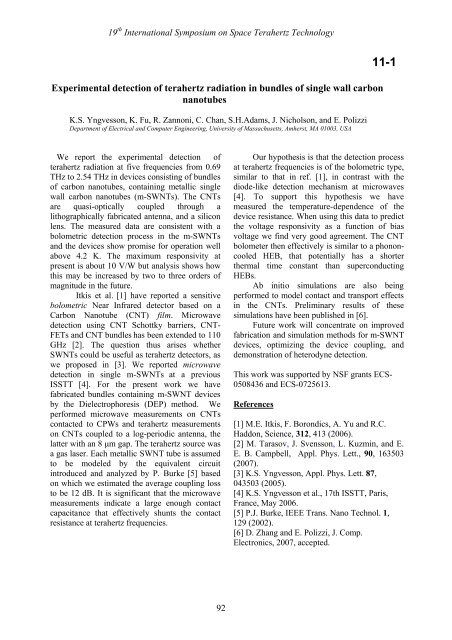Program and Abstract Book - SRON
Program and Abstract Book - SRON
Program and Abstract Book - SRON
You also want an ePaper? Increase the reach of your titles
YUMPU automatically turns print PDFs into web optimized ePapers that Google loves.
19 th International Symposium on Space Terahertz Technology<br />
Experimental detection of terahertz radiation in bundles of single wall carbon<br />
nanotubes<br />
K.S. Yngvesson, K. Fu, R. Zannoni, C. Chan, S.H.Adams, J. Nicholson, <strong>and</strong> E. Polizzi<br />
Department of Electrical <strong>and</strong> Computer Engineering, University of Massachusetts, Amherst, MA 01003, USA<br />
11-1<br />
We report the experimental detection of<br />
terahertz radiation at five frequencies from 0.69<br />
THz to 2.54 THz in devices consisting of bundles<br />
of carbon nanotubes, containing metallic single<br />
wall carbon nanotubes (m-SWNTs). The CNTs<br />
are quasi-optically coupled through a<br />
lithographically fabricated antenna, <strong>and</strong> a silicon<br />
lens. The measured data are consistent with a<br />
bolometric detection process in the m-SWNTs<br />
<strong>and</strong> the devices show promise for operation well<br />
above 4.2 K. The maximum responsivity at<br />
present is about 10 V/W but analysis shows how<br />
this may be increased by two to three orders of<br />
magnitude in the future.<br />
Itkis et al. [1] have reported a sensitive<br />
bolometric Near Infrared detector based on a<br />
Carbon Nanotube (CNT) film. Microwave<br />
detection using CNT Schottky barriers, CNT-<br />
FETs <strong>and</strong> CNT bundles has been extended to 110<br />
GHz [2]. The question thus arises whether<br />
SWNTs could be useful as terahertz detectors, as<br />
we proposed in [3]. We reported microwave<br />
detection in single m-SWNTs at a previous<br />
ISSTT [4]. For the present work we have<br />
fabricated bundles containing m-SWNT devices<br />
by the Dielectrophoresis (DEP) method. We<br />
performed microwave measurements on CNTs<br />
contacted to CPWs <strong>and</strong> terahertz measurements<br />
on CNTs coupled to a log-periodic antenna, the<br />
latter with an 8 μm gap. The terahertz source was<br />
a gas laser. Each metallic SWNT tube is assumed<br />
to be modeled by the equivalent circuit<br />
introduced <strong>and</strong> analyzed by P. Burke [5] based<br />
on which we estimated the average coupling loss<br />
to be 12 dB. It is significant that the microwave<br />
measurements indicate a large enough contact<br />
capacitance that effectively shunts the contact<br />
resistance at terahertz frequencies.<br />
Our hypothesis is that the detection process<br />
at terahertz frequencies is of the bolometric type,<br />
similar to that in ref. [1], in contrast with the<br />
diode-like detection mechanism at microwaves<br />
[4]. To support this hypothesis we have<br />
measured the temperature-dependence of the<br />
device resistance. When using this data to predict<br />
the voltage responsivity as a function of bias<br />
voltage we find very good agreement. The CNT<br />
bolometer then effectively is similar to a phononcooled<br />
HEB, that potentially has a shorter<br />
thermal time constant than superconducting<br />
HEBs.<br />
Ab initio simulations are also being<br />
performed to model contact <strong>and</strong> transport effects<br />
in the CNTs. Preliminary results of these<br />
simulations have been published in [6].<br />
Future work will concentrate on improved<br />
fabrication <strong>and</strong> simulation methods for m-SWNT<br />
devices, optimizing the device coupling, <strong>and</strong><br />
demonstration of heterodyne detection.<br />
This work was supported by NSF grants ECS-<br />
0508436 <strong>and</strong> ECS-0725613.<br />
References<br />
[1] M.E. Itkis, F. Borondics, A. Yu <strong>and</strong> R.C.<br />
Haddon, Science, 312, 413 (2006).<br />
[2] M. Tarasov, J. Svensson, L. Kuzmin, <strong>and</strong> E.<br />
E. B. Campbell, Appl. Phys. Lett., 90, 163503<br />
(2007).<br />
[3] K.S. Yngvesson, Appl. Phys. Lett. 87,<br />
043503 (2005).<br />
[4] K.S. Yngvesson et al., 17th ISSTT, Paris,<br />
France, May 2006.<br />
[5] P.J. Burke, IEEE Trans. Nano Technol. 1,<br />
129 (2002).<br />
[6] D. Zhang <strong>and</strong> E. Polizzi, J. Comp.<br />
Electronics, 2007, accepted.<br />
92
















